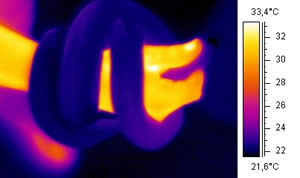Difference between Endotherm and Homeotherm
Key Difference: An endotherm is an organism that maintains its body temperature at a favorable degree without the help of external ambient heat. Endotherms do this by using or releasing the heat released by the internal processes. Homeotherm actually goes hand-in-hand with endotherms as homeothermy is the process of thermoregulation that is used to maintain a stable internal body temperature regardless of external influence. Endotherms actually use the process of homeothermy to keep their internal body temperatures under control.
 The terms endotherm and homeoterm are often confusing terms because of their similarities. The terms are related and refer to organisms that can automatically alter their bodily functions to control their inner temperature. Humans are endotherms as our body shivers to raise temperature and sweats to release extra heat from the body. It is quite an interesting concept, as the body automatically alters functions depending on the external temperature to maintain homeostasis.
The terms endotherm and homeoterm are often confusing terms because of their similarities. The terms are related and refer to organisms that can automatically alter their bodily functions to control their inner temperature. Humans are endotherms as our body shivers to raise temperature and sweats to release extra heat from the body. It is quite an interesting concept, as the body automatically alters functions depending on the external temperature to maintain homeostasis.
An endotherm is an organism that maintains its body temperature at a favorable degree without the help of external ambient heat. Endotherms do this by using or releasing the heat released by the internal processes. It’s is common knowledge that a moment one type of energy gets converted to another energy it releases heat. Even energy that is changing states among themselves release heat. On a day when it is hot outside, the body releases heat to maintain the internal temperature. On a cold day, the body consumes heat and increases internal functions to produce more heat. It also causes shivering to create more heat.
 An endotherm is able to maintain this temperature as compared to ectotherms (creatures that depend on external temperatures to main their own) because they have large number of mitcochondria per cell, which enables them to generate heat by increasing the rate at which they metabolize fats and sugars. In case of prolonged exposure to cold areas, the body is able to reserve heat by dropping the core bodily temperatures to below of those required to maintain homeostasis; this method is known as hypothermia. When exposed to heat, the human body responds by sweating, while other animals use different body functions such as panting (dogs) or moving their ears (elephants) to keep cool.
An endotherm is able to maintain this temperature as compared to ectotherms (creatures that depend on external temperatures to main their own) because they have large number of mitcochondria per cell, which enables them to generate heat by increasing the rate at which they metabolize fats and sugars. In case of prolonged exposure to cold areas, the body is able to reserve heat by dropping the core bodily temperatures to below of those required to maintain homeostasis; this method is known as hypothermia. When exposed to heat, the human body responds by sweating, while other animals use different body functions such as panting (dogs) or moving their ears (elephants) to keep cool.
Homeotherm actually goes hand-in-hand with endotherms as homeothermy is the process of thermoregulation that is used to maintain a stable internal body temperature regardless of external influence. Endotherms actually use the process of homeothermy to keep their internal body temperatures under control. The temperature is often higher than the immediate environment. The term ‘homeotherm’ is derived from the Greek words ‘homios’, meaning “similar” and ‘therme’, meaning “heat”. Not all homeothermic organisms, endothermic as some Homeotherms may maintain constant body temperatures through behavioral mechanisms alone, such as reptiles. Homeothery is one of the three types of warm-bloodedness and is opposite of poikilotherms (organisms whose internal temperatures vary).
Image Courtesy: lists7.com, coolexoticpets.com









Add new comment